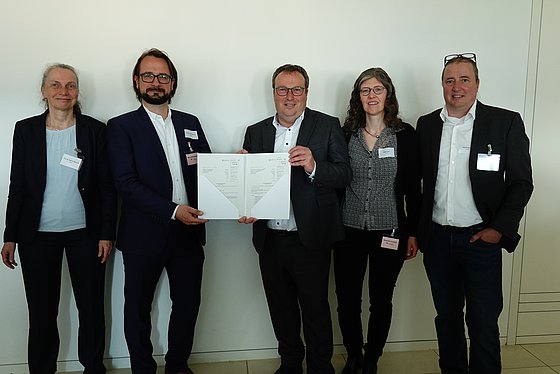Optimisation
Safe routes to school thanks to smart route planning - SAFER research project launched

Photo Colourbox

The project partners and the NRW Environment Minister: (from left) Prof Dr Kathrin Klamroth and PD Dr Michael Stiglmayr from the University of Wuppertal, Minister Oliver Krischer and Tanja and Jens Leuven from the bueffee research office // Photo Ministry of the Environment, Nature Conservation and Transport of the State of North Rhine-Westphalia (MUNV), click on the image for a larger version
SAFER aims to develop intelligent route planning that takes into account not only the shortest route, but also safety aspects and the quality of the route. Particular attention is paid to the evaluation of crossing points such as zebra crossings, traffic lights or central islands.
The project combines mathematical-theoretical innovation and practical application in transport planning: the digital tools developed in the project will enable safe routes to school and municipal footpath networks to be planned and implemented much more quickly in future.
Resolving conflicting goals
"In contrast to conventional navigation systems, SAFER does not simply weight different criteria such as speed and safety, but treats them as equal, (sometimes) conflicting objectives," explains Michael Stiglmayr from the optimisation working group. This is because the fastest route can sometimes be the most unsafe and therefore unsuitable as a route to school. A challenge for the calculation carried out by the navigation system: The safety assessment of the crossing points is based on an ordinal scale - in other words, a ranking - and not on a measurable variable as is the case with time and route length, for example.
"The different types of road crossings are each assigned a category according to their hazard potential," explains Stiglmayr. When calculating the route to school, the navigation system should of course take this assessment into account. "For us mathematicians, this results in what is known as an ordinal optimisation problem. Using the mathematical methods that solve the problem, we systematically analyse trade-offs between shorter and safer routes and ultimately determine a well-founded compromise solution," says the expert.
The Optimisation working group at the University of Wuppertal, represented by Prof. Dr Kathrin Klamroth, PD Dr Michael Stiglmayr and Dr Julia Sudhoff Santos, is one of the leading teams in the fields of multi-criteria network optimisation and ordinal decision processes.
Science meets practice
The close cooperation between science and practice has resulted in a novel approach to designing routes for the journey to school. "We are certain that safe routes to school will soon be much quicker to implement," says Jens Leven from project partner bueffee. The Wuppertal-based office for research, development and evaluation brings extensive experience in the field of school route safety and school mobility management from projects, primarily with cities and municipalities in North Rhine-Westphalia, to the SAFER project. One of the company's current research focuses is the behaviour of children at different types of road crossings. To this end, the office has already developed an innovative assessment procedure for use by traffic planners, which is now also being used in the SAFER project.
The SAFER project - safe, algorithm-based footpath routing - is being funded with 590,000 euros by the state of North Rhine-Westphalia and the European Regional Development Fund as part of the NeueWege.IN.NRW innovation competition.

